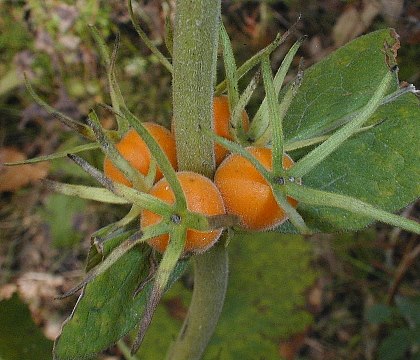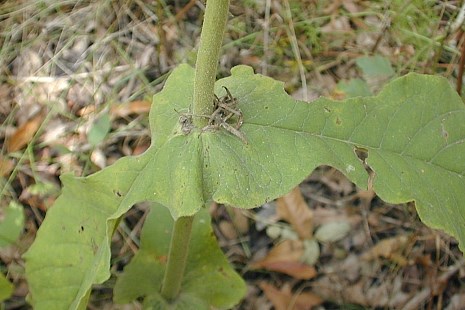Description: This perennial wildflower is 2–3½' tall and unbranched. The central stem is light green, terete, and pubescent. Pairs of opposite leaves occur at intervals along this stem; each pair of leaves rotates 90º from the orientation of the preceding pair of leaves. The leaves are up to 8" long and 4" across, ovate or ovate-oblong in shape, and smooth to slightly undulate along their margins. All or most leaves have winged bases that surround the stem and merge with the bases of the leaves on the opposite side. The upper surfaces of the leaves are dull green and hairless to slightly pubescent, while their lower surfaces are whitish green and covered with short fine pubescence. Sessile clusters of 1-5 flowers occur in the axils of the leaves. Each flower has a narrow tubular corolla (about ½" long); usually this corolla is reddish brown (less often, it is more green or yellow). The corolla has 5 lobes that are short and well-rounded. The 5 sepals are about the same length as the corolla and linear in shape; they are light green to dark reddish brown. At the base of each flower, there is a 3-celled ovary that is green and hairy, and a pair of linear stipules that resemble the sepals. Within the corolla, there are 5 stamens and a single style with a knobby green stigma.

The blooming
period occurs from late spring to mid-summer and lasts about a month.
Each flower is replaced by a dry drupe about 1/3" (8 mm.) across that
is
globoid in shape and becomes orange at maturity. Inside each drupe,
there are 3 black nutlets; these nutlets are 3-angled and oblongoid in
shape. The root system consists of a taproot. This wildflower spreads
by reseeding itself.
Cultivation:
The preference is light shade to dappled sunlight, mesic to slightly
dry conditions, and a loamy or rocky soil with abundant organic matter.
Range & Habitat:
Late Horse Gentian is occasional in central and northern Illinois,
becoming uncommon or absent in southern areas of the state (see Distribution
Map). This is a native wildflower. Habitats include upland
deciduous woodlands, rocky
wooded slopes, thinly wooded bluffs, oak savannas, and limestone glades.

Faunal Associations: The nectar of the flowers attracts long-tongued bees, especially bumblebees (Bombus spp.) and Anthophorid bees (Anthophora spp.). Smaller short-tongued bees may visit the flowers, but they are less effective at cross-pollination. The caterpillars of the moth Hemaris diffinis (Snowberry Clearwing) feed on Triosteum spp. (Horse Gentians) and other members of the Honeysuckle family. Sometimes White-Tailed Deer chomp off the upper half of the central stem and its leaves.
Photographic
Location:
An upland oak woodland in McLean County, Illinois.
Comments:
Late Horse Gentian is easily distinguished from other species of Horse
Gentian (Triosteum spp.) by its stem-surrounding
opposite leaves (they are connate-perfoliate). Other species in this
genus have opposite leaves that taper to narrow bases that are little
wider than the central stem. Except for this difference in their
leaves, Late Horse Gentian is very similar in appearance to Early Horse
Gentian (Triosteum aurantiacum) and they prefer
similar habitats. Another species, Triosteum angustifolium
(Yellow-Flowered Horse Gentian), has yellow flowers and more narrow
leaves; its state distribution is restricted to southern Illinois.